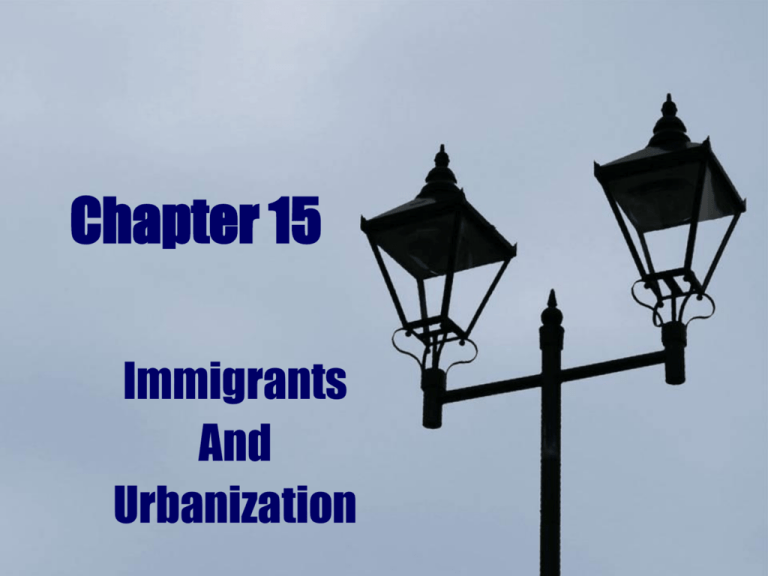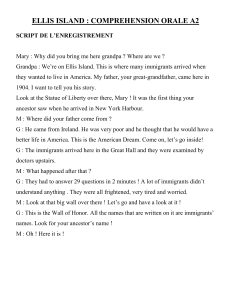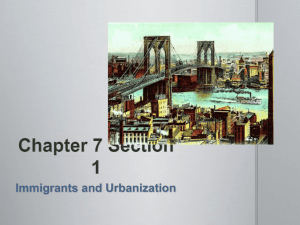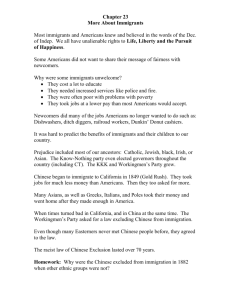Chapter 15
advertisement

Chapter 15 Immigrants And Urbanization • From the end of the Civil War until the beginning of the 20th Century, the size of US cities increased rapidly; this is known as urban growth. • In the West, new towns grew out of nothing as RR and settlements took hold. • In the East, established cities grew in population due to industrialization and the jobs it created. • Millions of immigrants came to the U.S. during the 19th and 20th Centuries in search of a better life. • Some hoped to escape famine, land shortages, or religious/political persecution. • Others only sought to temporarily earn money and return to their homelands. • Immigrants came from Europe, China, Japan, West Indies, and Mexico. • Europeans arrived at the East coast: Before 1890-came from Northern and Western Europe After 1890- came from Southern and Eastern Europe • Chinese and Japanese arrived at the West coast in small numbers, which were limited by the gov’t. • Most immigrants traveled via steamship to the U.S. • The journey could take several weeks. • Many immigrants were put into crowded, filthy quarters and hoped to survive the passage without sickness/disease. • Upon arrival, many immigrants faced the possibility of being sent back home. • When arriving at the East coast, immigrants landed at Ellis Island in NY Harbor. – Ellis Island was opened in 1892 as a reception center for the many new immigrants coming to the US • The process could take 5+ hours. • Immigrants had to pass a physical exam, interview with a gov’t inspector, and prove their mental abilities. • Those arriving at the West coast entered at Angel Island in San Francisco Bay. • Immigrants (mostly Chinese) faced harsher questioning and a long stay in bad conditions. • Once admitted to the country immigrants faced the obstacles of finding a place to live, finding work, and learning the language. • Many found people of common origins and formed communities together. • They often kept the culture of their home country alive by building cultural stores, churches, and other groups. • Native-born Americans tended to think of the U.S. as a melting pot-mixture of people and cultures who blended together and abandoned native ways for American ways. • This encouraged the ideas of nativism-favoring native-born citizens over immigrants. • Nativists believed certain races were inferior and objected to their religious and social beliefs. • The American Protective Association restricted the rights of Catholics and Jews. • The Immigration Restriction League influenced Congress to require a literacy test for immigrants. • Congress also passed the Chinese Exclusion Act in 1882 to ban Chinese immigration. It stayed in effect until 1943. • Only students, teachers, merchants, tourists, and gov’t officials were allowed. • Looking Backward • During the 19th and 20th Centuries industrialization would lead to urbanizationrapid growth of cities, especially in the Northeast and Midwest. • Because of immigration, the Americanization movement was created to assimilate people of different cultures into the dominant culture. • This movement was sponsored by gov’t officials, schools, and volunteer groups who taught about citizenship, English, History, social etiquette, and American culture. • As populations increased, so did the problems faced by city gov’ts: • Housing (tenement homes) • Transportation (mass transit-electric trolleys) • Water • Sanitation • Crime • Fires • All of these problems led to the Social Gospel Movement which encouraged helping the urban poor. • Some reformers built settlement houses or community centers. – Jane Addams opened the Hull House in Chicago. It not only helped the urban poor, but served as a launching pad for investigations into the political, economic, and social conditions in the city. • These centers provided assistance for the poor and educated people about urban problems. JANE ADDAMS







